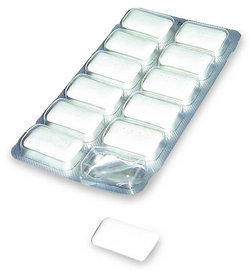Chewing gum

Chewing gum is a type of confectionery which is designed to be chewed, not swallowed. Traditionally, it was made of chicle, a natural latex product, although for reasons of economy many modern chewing gums use petroleum based plastic instead of chicle. Chicle is nonetheless still the base of choice for some "upscale" gum brands, as well as some regional markets, such as that of Japan.
History of Gum
Chewing gum, in various forms, has existed since at least Ancient Greece. The Greeks chewed mastic gum, made from the bark of the mastic tree. Betel, a mild narcotic, has enjoyed popularity in India for millenia. Many other cultures have chewed gum like substances made from plants, grasses and resins.
The American Indians chewed resin made from the sap of spruce trees. The New England settlers picked up this practice from the Indians. In the early 1880s attempts were made to commercially market spruce gum. Around 1850 a gum made from paraffin wax was developed and soon exceeded the spruce gum in popularity.
Modern chewing gum was first developed in the 1860s when chicle was imported from Mexico for use as a rubber subsititute. Chicle didn't pan out as a replacement for rubber, but as a gum it soon dominated the market. Chicle gum, and gum made from similar latexes, had a smoother and softer texture and held flavor better.
William Semple filed the first patent on chewing gum (patent number 98,304) in 1869.
Types of Gum
The standard type of gum is a small stick or wad of gum. Gum comes in a variety of flavors, depending on location and is most often chewed for the flavor.
Nicotine gum is designed especially for people who are trying to quit smoking. The gum contains a small amount of nicotine to combat cravings, and gives the former smoker something to do besides hold a cigarette in their mouth.
Several types of gum are designed specifically for dental hygiene. There are gums to whiten teeth, clean teeth, and freshen breath.
Bubblegum is a type of chewing gum that is especially designed for blowing bubbles.
Gum and Society
Unusually for a confectionery, chewing gum has some health benefits; unsweetened (sugar free) chewing gum stimulates saliva production, and helps to clean the surface of the teeth, whilst even sugary gum may be helpful, as the sugar dissolves out very quickly.
When spat on the ground, chewing gum will stick firmly and can only be removed with great difficulty. For this reason, the sale of chewing gum has been prohibited in Singapore since 1992. [1] Recently, however, some types of chewing gum (e.g. nicotine replacement gums) have been allowed under strictly monitored distribution.
An old wives' tale states that chewing gum, if swallowed, may take up to seven years to become fully digested, and that swallowing gum could also result in the substance becoming lodged in the oesophagus. This is untrue, and although chewing gum does resist complete digestion by the body, it is expelled like other foods, though relatively unchanged. There is also a very low, but real risk of gum becoming lodged inside the body. [Snopes]
Popular Brands
- Adam's Clove
- Bazooka Joe
- Beech-Nut
- Beemans
- Black Jack
- Chiclets
- Clark's Teaberry
- Marukawa
- Wrigley's
- Dentyne (Cadbury Adams)
See also: List of chewing gum brands
